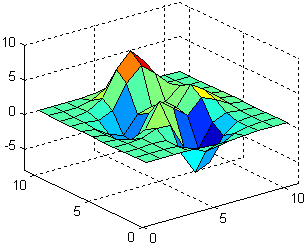Signal\Block Diagram Non-Linear
Domains: Continuous. Size: 1-D. Kind: Block Diagrams.
This model uses a two-dimensional table with data points to calculate the output z = f(x,y) as a function of the input x and y. The output z is calculated using linear interpolation between the table data points.
| • | The first row denotes the x-values and the first column denotes the y-values. |
| • | The input data of the first column and first row needs to be monotonically increasing. |
| • | Discontinuities are allowed, by providing the same input point twice in first row or first column of the table. |
| • | Values outside of the table range, are computed by linear extrapolation of the last two points. |
A table must be stored as an ASCII (text) file and should consist rows and columns of data. The first row consists of the x-values first column consist of the y-values. The row-column pairs are the corresponding z-values. Values must be separated by a space or a tab. No comment or other text may be part of the table-file. The filename of the input file can be specified using the complete path (e.g. c:\data\data.tbl ). When no path is given, the file is assumed to be in the experiment directory.
Suppose we want to use the well known Matlab peaks function:

This function can be put in a matrix form as:

The first row and column denote the x-values and y-values and the other row-column pairs the corresponding peaks function values. This matrix can be entered in a text file:

The model 2DTableLookup.emx (Examples\Signal Processing) shows how to use this text file as a 2-D table.
Inputs |
Description |
input1 input2 |
x-value y-value |
Outputs |
|
output |
z-value |
Parameters |
|
filename |
The filename of the table file. |



